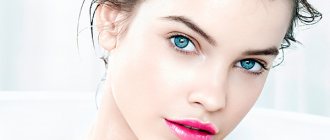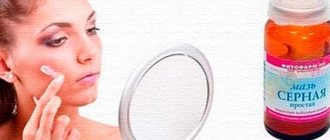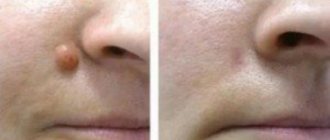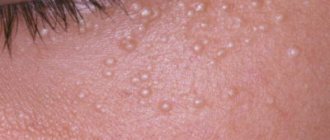Demodecosis is a skin disease caused by the demodex mite. It is also called the iron woman. It is transparent and invisible to the naked eye.
Normally, this mite lives on the surface of the skin of any person and is part of the normal microflora. Ticks feed on decay products in the upper layers of the epidermis. When the immune system malfunctions and other negative factors occur, mites multiply too actively and “settle” in the ducts of the sebaceous glands, causing inflammation. In addition to the skin, demodex affects the roots of the eyelashes.
What to do in such a situation? To get started, we recommend reading this article. This article describes in detail methods of controlling parasites. We also recommend that you consult a specialist. Read the article >>>
As an independent disease, demodicosis is not identified as a separate disease by most doctors, since it is always preceded by another pathology or poor hygiene. The disease often occurs against the background of acne, dematitis and rosacea. Inflammatory phenomena and vascular pathologies cannot but affect the state of the skin microflora, the balance is disturbed and the mite multiplies more actively.
Demodectic mange can be provoked even by prolonged exposure to the sun, which is stressful for our skin and causes a decline in local immunity. Violation of the rules of personal hygiene - rare change of towels and bed linen, rare washing, foreign cosmetics.
You shouldn’t get too carried away with hygiene either - frequent visits to baths and saunas can provoke a vascular reaction, which will cause demodicosis. Poor nutrition, prolonged use of hormonal ointments, and frequent acute respiratory viral infections affect the general and local state of immunity.
Causes of demodicosis on the face
Demodectic mange on the face affects a person regardless of gender or age. Demodex mites begin to multiply intensively under the following conditions:
- reduced immunity;
- hyperfunction of the sebaceous glands;
- constant stress;
- using cosmetics with hormonal supplements;
- bad ecology;
- disruptions in metabolic processes;
- changes in hormonal levels;
- during exacerbation of chronic diseases.
Bad habits (smoking, alcohol, coffee, spicy food), frequent visits to the sauna and solarium increase the development of the disease.
Hormonal changes lead to disruptions in skin PH. A slightly acidic environment becomes alkaline and enhances the growth of microorganisms. The increase, which does not have time to absorb dead individuals and sebum residues, provokes the appearance of yeast-like fungi, which causes irritation and itching on the skin. When scratching itchy areas, the skin becomes infected with streptococci and staphylococci.
Symptoms
Since there is demodicosis of the eyelids (eye form) and a skin disease, there will be different types of symptoms for these two forms.
Symptoms of demodicosis on the skin are manifested by the following:
- acne: from nodules and pustules to rosacea;
- a feeling of itching that causes severe discomfort. It manifests itself most strongly at night and in the evening;
- increased skin oiliness. It is the greasy environment that best promotes the proliferation of ticks;
- red areas of the skin, which indicate increased pressure in the blood vessels. It is associated with inflammation of the skin;
- growth of the wings of the nose. In advanced cases, they increase in size as the functioning tissue is replaced by connective tissue.
The following symptoms are typical for the ocular form of the disease:
- eye fatigue. It is caused by inflammation and the fact that the patient is forced to constantly focus his vision and strain;
- eyelash loss. This is explained by the fact that the mite attacks the hair follicles;
- sticking of eyelashes. The formation of a thin film along the eyelash growth line due to inflammation is precisely the reason for this undesirable effect;
- redness and inflammation of the eyelids. In many cases, this greatly complicates the patient’s life and reduces the level of comfort.
Since some of these signs may indicate other diseases, demodicosis in humans requires additional research methods to make an accurate diagnosis.
How to diagnose a tick?
To identify demodex mites, it is necessary to conduct a careful examination. To do this, a scraping of the epithelium is taken and examined under a microscope. During examination, it is not always possible to make an accurate diagnosis the first time.
If you have signs of demodex on your face, you should stop washing your face for 3 days, then go for examination. All waste products and dead individuals will be on the surface of the skin. Sometimes it is necessary to take eyelash and eyebrow hairs for examination. The mite may be in the mucous membrane of the eye, and can cause a relapse.
Symptoms of demodex on the face:
- formation of enlarged pores (an increased number of microorganisms does not fit in the follicles, causing an external skin defect);
- the appearance of red pimples with purulent filling;
- increased work of the sebaceous glands;
- gray skin color.
If eyebrows and eyelashes are damaged, their loss is observed, and the skin of the eyebrows peels off. Mites cause an unpleasant noise in the ears. The advanced form of the disease is characterized by a puffy skin condition with a yellow-brown tint, and ulcers at the site of acne. After a thorough examination, the doctor will advise how to cure demodex and how to behave during the illness.
Features of demodicosis of the eyelids
Blepharitis has quite a lot of varieties, which have one thing in common: they all cause discomfort to a person and are a threat to his vision and the body as a whole.
In this article
- Features of demodicosis of the eyelids
- Demodicosis of the eyelids: symptoms and diagnosis
- Causes of eyelid disease
- Treatment
- Treatment regimen
- Medicines
- Non-drug therapy
- Prevention
The causes of the disease and its type can only be diagnosed by a doctor. Demodex mites are opportunistic parasitic organisms that live in hair follicles and meibomian glands. About 70% of the population are its carriers, but Demodex manifests itself only in cases where the body’s protective barriers are weakened and there is a metabolic disorder. Most often the disease occurs in middle-aged and elderly people. It can also appear in children with chronic diseases of the gastrointestinal tract, lungs and children suffering from farsightedness.
As a rule, the mite is located on the eyelids, facial skin, forehead, chin, and nasolabial folds. Its waste products provoke:
- allergic reactions;
- development of seborrhea and acne on the face;
- eye damage.
Demodicosis of the eyelids is chronic and can worsen in spring and autumn. It is quite difficult to cure; on average, the treatment process takes 2 months.
Treatment options
Treatment for symptoms should be prescribed by a doctor depending on the type of bacteria and the severity of the disease. Typically, it takes 1 to 3 months to completely get rid of these parasites. Patients are prescribed antibiotics and antibacterial agents. Vitamins, lotions, masks, tar soap and even cryomassage are used.
How to treat damage to demodex mites should be decided by the doctor. As a rule, the entire course of treatment is divided into stages. First of all, they destroy the parasites living under the skin, and only then get rid of the consequences of their activity, acne and red spots.
The main difficulty in treating demodex bream on the face is that this arthropod is protected by a dense shell through which drugs penetrate poorly. That is why several remedies are used at once - antibiotics and special ointments, which have both an external and internal effect.
Prevention
As mentioned above, the demodectic form develops with reduced immunity and poor metabolism. This explains the importance of saturating the body with microelements and substances. This can be done with the help of special preparations and fortified complexes.
Chronic blepharitis tends to return, so people who have already had it once should undergo a preventive course of treatment at least once a year. Preventive medications can be purchased at any pharmacy. Among the preventive measures:
- Maintain hygiene rules: touch your face with clean hands, wash your face when you are in dusty rooms and when there is increased sweating in hot weather, use safety glasses when working with chemicals or bright lighting.
- Avoid injury to eyes.
- Do not neglect glasses if you have diagnosed visual impairments.
- Take breaks from work, avoiding excessive eye strain.
Express treatment
Not every patient will be morally inclined to undergo long-term treatment for subcutaneous demodex mites when they find out that parasites are crawling under their skin. Despite the fact that any inflammation must be treated comprehensively, there are several methods that make it possible to significantly speed up and simplify this process.
We are talking about the following procedures:
- Cosmetological facial cleansing (mechanical removal of acne). The advantages are quick relief from the symptoms of demodex. The downside is that cleaning cannot kill the pests themselves. Even after cleaning, mites will continue to exist and reproduce.
- Highly concentrated means of destruction. This technique literally allows you to get rid of damaged upper layers of facial skin. It develops burns similar to sunburn, and the skin begins to peel off. During the regeneration process, the upper layers come off and the lower ones become clean. However, the effect does not last long, because over time the tick makes itself felt again.
If these methods are used in combination with other procedures (how to treat demodex mites on the face is described in detail above), it is possible to get rid of parasites much faster and more effectively. That is why it is worth considering these methods in more detail.
Lotion for getting rid of subcutaneous mites
The degree of neglect of the disease dictates the basic conditions for its further treatment. The standard treatment regimen includes the use of topical preparations - ointments, gels and other products that can be applied directly to the mite-affected skin. For the ointment, a prerequisite is the content of a concentrated component - metronidazole. Effective lotions for the treatment of demodicosis:
- Eyes n Mites alcohol-free lotion. The lotion, which can be used for sensitive eyelid skin, is suitable for both basic treatment and prevention of an unpleasant disease.
- Antidemodex lotion CLEANSER. The transparent liquid has anti-inflammatory properties, so it quickly eliminates obvious inflammation caused by the proliferation of subcutaneous mites.
When prescribing a lotion, the individual tolerance of certain components by the patient is taken into account, because during the treatment period the protective properties of his body deteriorate significantly. Caution in the selection of such funds is mandatory.
Face cleaning
Facial cleansing is a cosmetic procedure that allows you to quickly get rid of most visible skin imperfections, including acne and blackheads. There are two types of facial cleansing - manual and mechanical. If the first has been known since the times of the USSR, then the second appeared relatively recently and raises some doubts among most visitors to beauty salons.
Mechanical cleaning can be carried out only in cases where there are no open or closed comedones on the patient’s face. A comedon is a kind of “plug” that is formed due to blockage of the hair follicle. This is preceded by accumulations of dirt and sebum, blocking the pores.
If there are no comedones on the face and there are no other medical contraindications (individual intolerance to the drugs used), mechanical cleansing can be performed.
Causes of eyelid disease
Infection with tick-borne blepharitis occurs through contact and household contact. The infection is hidden in bedding (such as feather pillows) or dust. Ticks can also appear from the outside: they are able to live autonomously in humid conditions for up to three days.
The cause of the development of the disease can also be disturbances in the functioning of the nervous or endocrine systems, liver, and gastrointestinal tract. Also, the likelihood of infection increases due to heredity.
Other factors that provoke the occurrence of demodectic blepharitis:
- sunburn or prolonged exposure to high temperatures;
- non-compliance with sanitary standards;
- ophthalmological operations;
- acne-prone skin;
- frequent peelings and facial cleansing, solariums and an overabundance of other cosmetic procedures.
Mechanical facial cleansing
Quite often, mechanical cleaning is mentioned as one of the ways to treat the symptoms of demodex mites on the face. However, as has already become clear, with its help you can only get rid of the consequences of demodicosis, and the destruction of the parasite itself is somewhat more complicated.
Nevertheless, it is worth taking a closer look at this cosmetic procedure, because it can be done not only to eliminate deficiencies, but also as a preventive measure against their occurrence. Mechanical facial cleansing occurs in several stages:
- First of all, the patient’s face is treated with a composition that helps expand the pores. This could be a special cream, lotion or mask. After achieving the desired effect, the cosmetologist proceeds to the next stage of processing.
- Using sterile treated instruments, mechanical facial cleansing is carried out to remove blackheads and other formations. This procedure is also called comedone extraction.
- The final stage includes disinfection and the use of skin soothing products. As a rule, various tonics and lotions are used for this. Different cosmetologists may use products from different cosmetic brands in their work.
Do not apply makeup immediately after cleansing. After a while, the procedure must be repeated. The duration of the course is determined by a specialist and depends on the individual characteristics of the client.
Form of release of drugs against demodicosis for external use
The effectiveness of topical medications depends on many factors. Affect:
- localization of damage;
- affected area;
- depth of parasite penetration;
- form and nature of pathology;
- general health of the patient.
Ointment is a convenient form of release for local therapy. The drug can be single-component or contain several active ingredients that complement each other. The base substance of the ointments is neutral, does not cause allergies and does not change its properties after application to the skin or under the influence of temperature.
Cream for demodicosis is the best choice for patients whose skin, under the influence of subcutaneous mites, has lost its elasticity and become dry. This form of release allows you to moisturize the surface of the body, penetrating into the deep layers of the skin, and reduce the inflammatory process. In addition to the main cause of the pathology, the cream also helps to overcome the consequences of its development.
Each active ingredient in the drug has its own advantages, but we must not forget about contraindications - when choosing a drug for local therapy, you need to consult a dermatologist or carefully study the instructions for the drug.
Folk remedies
For successful treatment, the following recommendations must be followed:
- Daily cleansing of the facial skin with a special gel for problem skin;
- Wash with warm water and then apply lotion;
- After this, medicated creams and ointments can be applied;
- Do not touch your face with your hands;
- Closely monitor the cleanliness of the skin and prevent contamination;
- Avoid direct sunlight;
- Get rid of the bad habit of squeezing pimples.
There are several effective treatment methods that can be carried out at home without having medications on hand:
- Mask with clay and herbs - dilute white or blue clay in a decoction of herbs (chamomile, calendula, nettle). Apply to cleansed skin, after drying (about 20 minutes), wipe off and rinse face with cool water;
- Herbal preparations - use petals of mint, string, plantain, nettle. They are crushed, poured with boiling water and allowed to brew. Drink 3-4 times a day before meals;
- Herbal infusions - used to wipe and cleanse the skin (tincture of calendula, wormwood, elecampane root);
- Tar soap – for washing (1-2 times a day).
It should be remembered that each person’s skin has its own characteristics, so an individual approach to treatment is necessary.
You need to be careful when using traditional medicine methods, because if used incorrectly, you can aggravate the course of the disease.
How to cure?
Amateur treatment can lead to prolongation of the disease and the occurrence of allergic reactions. To achieve results, an individual treatment regimen is prescribed based on laboratory tests, skin characteristics, dynamics and localization of the disease. There are many effective drugs for demodicosis; it is important to choose the appropriate set of drugs in order to be cured quickly and without complications. In addition, for treatment you must adhere to the following rules:
- do not use decorative and skincare cosmetics for the face - they create a favorable environment for mites to reproduce;
- do not use decorative cosmetics that were used before diagnosis and treatment;
- use disposable paper towels after washing;
- use organic shampoos and hygiene products;
- refuse to visit the solarium, sauna, bathhouse;
- do not take baths, avoid long stays in the shower;
- do not expose the skin to sunlight;
- regularly wash and iron all items, towels, bed linen that have been in contact with contaminated areas;
- follow a diet, completely abandon foods prohibited for demodicosis;
- normalize the activity of the gastrointestinal tract and liver;
- actively treat the internal causes that provoked demodicosis, do not leave it for later;
- After recovery, follow the doctor’s recommendations to prevent relapse.
Drugs
Medicines can only be used under the supervision of a doctor.
The most effective in combating ticks are acaricidal preparations, creams, ointments, and drops. Permethrin ointment has proven itself well, which destroys not only adults, but also masonry, and has virtually no side effects or contraindications. Ointments based on sulfur and tar are effective, but have a strong odor, which is not always convenient for regular use. Ointments based on zinc oxide are harmful to ticks. Advanced demodicosis is often treated with such aggressive skin preparations as benzyl benzoate ointment. Preparations containing metronidazole also cope with demodex colonies, but due to toxicity they have a number of contraindications.
Folk remedies
It is unlikely that it will be possible to cure demodicosis using folk methods, but such remedies are suitable for relieving unpleasant symptoms and increasing immunity. Herbal decoctions are used for oral administration, external compresses and washing. A particularly popular remedy is wormwood. Its decoction is used to cleanse the body, but you should be careful - wormwood causes ulcers in some stomach diseases. Tar soap is a good external remedy; it is used both during treatment and during the prophylactic period. Natural components of folk remedies do not guarantee safety, and their use should be agreed with a doctor.
Physiotherapy
In modern cosmetology clinics, a number of procedures are performed to treat mites. In each case, the method of influencing the affected areas is selected individually and is a complement to the main treatment. Electrophoresis is widely used to reduce mite activity and increase the effectiveness of drug treatment. In ozone therapy, the affected areas are treated with an oxygen-ozone mixture. Laser treatment is indicated; photocoagulation destroys demodex using pulsed light. The clinic also carries out effective procedures to restore the skin and eliminate the consequences of advanced demodicosis, such as scars, spots, and bumps. But it is better not to lead to such consequences and treat demodicosis in a timely manner.
Diet for illness
Proper nutrition plays a key role in the treatment of demodicosis. Nutrition is not only energy, but also macro- and microelements, vitamins and many other substances our body needs to fight disease.
You need to adjust your diet as follows:
- Avoid foods that contain large amounts of salt and sugar;
- Avoid fried, smoked, fatty foods;
- Quitting alcohol;
- Increase the content of vegetables and fruits in the diet;
- Add foods containing a large amount of fiber (bread, wheat, buckwheat, oatmeal, rice, potatoes, apples, carrots);
- A sufficient amount of fermented milk products (kefir, yogurt, milk).
Non-drug therapy
Treatment of blepharitis can be carried out not only with the help of medications. Non-drug therapy can also be carried out. So, it is useful to wipe your eyelids with decoctions of calendula or chamomile, or make lotions from green or black tea. To enhance the effect, you should resort to physiotherapy. It is worth taking medications to strengthen the immune system: vitamins and vitamin-mineral complexes. During treatment, it is recommended to avoid spicy, sour and salty foods. It is necessary to seek the help of specialists such as a dermatologist, nutritionist, gastroenterologist and allergist. To cleanse the skin, you can use soap with added tar and rinse it off thoroughly, avoiding contact with the cornea. Additionally, tansy can be used as an antiparasitic agent, a strong decoction of which should be rubbed into the surface of the head. Another effective remedy is propolis. It is necessary to dissolve 5 grams in 100 ml of water and instill this solution into the eyes. This will help relieve irritation, dryness and itching.
Kalanchoe juice will help get rid of skin ulcers: the product should be applied to the edges of the eyelids with a cotton swab. If the crust does not come off the eyelids and pus forms, it is worth treating the area with brilliant green diluted with vegetable oil. Tinctures of ginseng root, eleutherococcus, and echinacea are also indicated for the treatment of blepharitis. An integrated approach will help get rid of this complex eye disease.
It is possible to defeat parasites!
Antiparasitic Complex® - Reliable and safe removal of parasites in 21 days!
- The composition includes only natural ingredients;
- Does not cause side effects;
- Absolutely safe;
- Protects the liver, heart, lungs, stomach, skin from parasites;
- Removes waste products of parasites from the body.
- Effectively destroys most types of helminths in 21 days.
There is now a preferential program for free packaging. Read expert opinion.
Interesting to know:
Description of the pathogen
What is demodicosis? Demodex mites are microscopic parasites that live comfortably on human skin. Not all patients know about this type of pathogen.
Therefore, the question is often heard: “What is Demodex? What are the reasons for its manifestation?
Ticks of this subspecies are very small in size, and therefore it is simply impossible to replace them with the naked eye. Their length is less than one millimeter, and they do not have any shade.
The most suitable habitat for ticks is the sebaceous gland on the body or facial area. They can also be located in hair or eyelash follicles.
Parasites feed on subcutaneous fat, cosmetics based on vegetable fats, and cells from hair follicles.
If a person has been diagnosed with demodex, skin treatment should begin immediately. And there are several reasons for this. First of all, the mite sucks out all the beneficial substances from the hair follicles and skin. Because of this, some areas become swollen, red, and pimples appear. The worst thing is when demodicosis leads to hair loss.
The demodex mite spreads pathogens throughout the face, neck and body and affects the pores and deep layers of the skin. If the parasite is present, the patient may experience itching and flaking in the affected area.










